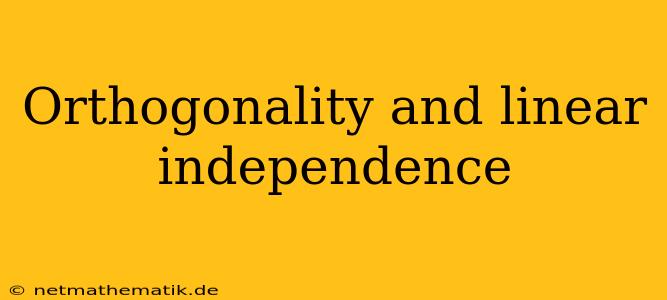The Essence of Independence: Exploring Orthogonality and Linear Independence
In the realm of linear algebra, the concepts of orthogonality and linear independence stand as pillars of understanding, guiding us in navigating the complexities of vector spaces and their relationships. These seemingly distinct ideas are intrinsically linked, offering insights into the structure and behavior of vectors. While orthogonality defines the geometric notion of perpendicularity, linear independence delves into the algebraic concept of vectors not being expressible as linear combinations of each other. This article aims to unravel these concepts, highlighting their interconnectivity and exploring their profound implications in diverse fields.
Delving into Orthogonality: The Geometry of Perpendicularity
Orthogonality, at its core, embodies the concept of perpendicularity between vectors. Two vectors are considered orthogonal if their dot product equals zero. This geometric interpretation translates seamlessly into the realm of Euclidean spaces, where we visualize vectors as arrows emanating from the origin. In this context, orthogonal vectors form a right angle, signifying a lack of shared direction.
Illustrative Examples:
- In the two-dimensional space, the vectors (1, 0) and (0, 1) are orthogonal, as their dot product (10 + 01) is zero. These vectors represent the standard basis vectors along the x and y axes, respectively, demonstrating the perpendicular nature of these axes.
- Extending this concept to higher dimensions, we can consider the vectors (1, 0, 0) and (0, 1, 0) in three-dimensional space. These vectors are orthogonal as their dot product (10 + 01 + 0*0) is zero. These vectors represent the basis vectors along the x and y axes, respectively, highlighting the perpendicularity of these axes in three dimensions.
Significance of Orthogonality:
The concept of orthogonality holds immense significance in various fields, including:
- Signal Processing: Orthogonal signals are crucial in communication systems, enabling efficient transmission and decoding of information without interference.
- Machine Learning: Orthogonal basis functions are used in dimensionality reduction techniques like Principal Component Analysis (PCA), allowing us to extract relevant features from high-dimensional datasets.
- Quantum Mechanics: In the realm of quantum mechanics, orthogonality plays a fundamental role in defining distinct states of particles.
Unraveling Linear Independence: The Algebraic Notion of Non-Redundancy
Linear independence delves into the algebraic relationship between vectors. A set of vectors is linearly independent if no vector in the set can be expressed as a linear combination of the other vectors. In essence, this signifies that each vector contributes uniquely to the span of the set, without redundancy.
Understanding Linear Combinations:
A linear combination of vectors involves multiplying each vector by a scalar and summing the resulting scaled vectors. For instance, given vectors u and v, a linear combination would be represented as au + bv, where 'a' and 'b' are scalars.
Defining Linear Independence:
A set of vectors is linearly independent if the only linear combination that results in the zero vector is the trivial one, where all scalars are zero. In other words, no vector in the set can be written as a linear combination of the other vectors.
Illustrative Examples:
- Consider the vectors (1, 0) and (0, 1) in two-dimensional space. These vectors are linearly independent because no scalar combination of one vector can produce the other.
- In contrast, the vectors (1, 2) and (2, 4) are not linearly independent. The second vector can be expressed as a linear combination of the first vector (2*(1, 2)).
Importance of Linear Independence:
Linear independence is a cornerstone of linear algebra, underpinning various key concepts, including:
- Basis of a Vector Space: A basis for a vector space consists of a set of linearly independent vectors that can span the entire space.
- Solution of Linear Equations: The number of linearly independent equations in a system determines the number of free variables, influencing the existence and uniqueness of solutions.
- Rank of a Matrix: The rank of a matrix is determined by the number of linearly independent rows or columns, providing insights into the matrix's properties.
The Intertwined Relationship: Orthogonality and Linear Independence
While orthogonality is a geometric notion, and linear independence is an algebraic concept, they exhibit a profound connection. Notably, a set of orthogonal vectors is always linearly independent. This assertion stems from the fact that if a vector can be expressed as a linear combination of other orthogonal vectors, the dot product of this vector with each of the others would be non-zero, contradicting the definition of orthogonality.
Example:
Consider the vectors (1, 0) and (0, 1) in two-dimensional space. They are both orthogonal and linearly independent. This illustrates the principle that orthogonality implies linear independence.
Implications:
The connection between orthogonality and linear independence has far-reaching implications:
- Basis Selection: Orthogonal sets often serve as ideal bases for vector spaces, ensuring that each vector can be uniquely represented without redundancy.
- Matrix Decomposition: Many matrix decomposition techniques, like QR decomposition, rely on constructing orthogonal matrices, leveraging the properties of both orthogonality and linear independence.
- Data Analysis: In fields like data analysis, orthogonal basis functions are employed in techniques like Fourier analysis, allowing us to decompose complex signals into simpler, independent components.
Conclusion: Embracing Independence in the Realm of Linear Algebra
In conclusion, orthogonality and linear independence are fundamental concepts in linear algebra, offering insights into the structure and behavior of vectors. Orthogonality provides a geometric framework for understanding perpendicularity, while linear independence delves into the algebraic notion of non-redundancy. The interconnectivity between these concepts emphasizes their profound impact on various fields, from signal processing and machine learning to quantum mechanics and data analysis. By comprehending the essence of independence embodied in these concepts, we gain a deeper appreciation for the rich tapestry of linear algebra, enabling us to unravel the intricate relationships between vectors and unlock their potential in diverse applications.
